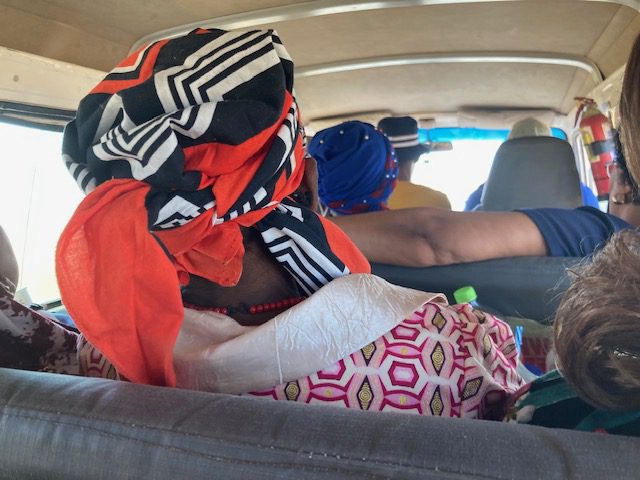First things first: Namibia is a vast country mainly made up of the Namib desert and desert-like environments, and is extremely sparsely populated, especially in the south. Many of Namibia’s most beautiful spots are only accessible with a private car, not by public transport unfortunately. So in terms of environmentally friendly travel, Namibia is not going to be your top destination.
If you are planning to visit Namibia, you might want to consider renting a car together with some other travellers that have the same destinations in mind as you. Also, don’t listen too much to what the car rental and tourism agencies will tell you about needing a huge four-wheel-drive vehicle. Most of the roads are in very good shape, despite being mostly gravel roads. They also seem to be continuously maintained. So unless you want to go to Sandwich Harbour or drive the last bit in the sand to Sossusvlei, you are fine with a normal car that emits way less than one of the white truck monsters with integrated roof top tent. Just bring a normal tent and you’ll be fine travelling with a normal car. Except some farmers, all the locals drive regular cars as well. When self-driving, always carry a few coins with you as it is customary to tip parking lot attendants (i.e. guys in yellow vests that help you park and then keep an eye on your car) in front of supermarkets and restaurants, as well as attendants at service stations. About 5 Namibian dollars (~0,25€) are appropriate.
You can also try hitch-hiking, but you might be in it for a long wait under the blazing sun because of the vastness of the country. In some parts of the country (mainly the south), you can drive for several hours without ever encountering as much as another car. Also, be aware that there are really not many people living in the country, so keep that in mind when you look at a map. Some of the ‘towns’ on a map will actually turn out to be simply a gas station and a couple of private houses or in the case of ‘Helmeringshausen’ actually only a hotel, nothing else. However, drivers do usually stop when they see people along the road and will probably give you a lift if you are headed in the same direction. There is a kind of beautiful solidarity among people in the desert.
All of this said, there are public transport routes between most cities (Windhoek, Swakopmund, Walvis Bay, Keetmanshop, Luederitz, Mariental, Maltahoehe, more in the north, but I didn’t go there) and there is a comprehensive taxi network in the capital Windhoek. There used to be a great rail network as well, but since Covid-19 it is not what it was before. You can go to the main station in Windhoek and ask about the next train to your destination; however, when I did just that wanting to go south to Mariental, I was told there would only be a train going north in a couple of days and they couldn’t tell me when the next train going south would leave. So your best option is to take a minibus to get around.
Here is how the inter-city public transport works in Namibia
1, Ask around for the minibus/taxi rank to go to your destination. Often, there are several ranks, depending on the destinations, e.g. one rank for travel northwards, one rank for travel southwards.
2, Go to the right minibus/taxi rank. It is best to go rather early in the morning to be sure you get to your destination before dark and also because there sometimes aren’t that many minibuses leaving to some destinations, only e.g. one at 9.00 in the morning and one at 16.00 in the afternoon.
3, Ask either a driver or anybody who seems approachable where the bus going to XY is. Usually someone will ask you where you are going as soon as you approach the parked minibuses and even take your bag and show you to the right minibus.
3, At the indicated minibus, ask either a passenger, the conductor or the driver to confirm the destination. Then you can put your bag on the trailer if there is one or wherever they tell you to put it.
4, Take a seat. In my experience it is best to sit rather in one of the front rows than in the back. This is because the driver will most likely blast music all the way and the speakers are usually in the back.
5, Ask the driver, conductor, or a passenger for the price to go to your destination. To go from Windhoek to Mariental I paid 200 Namibian dollars (~10,5€) to give you an example.
5, Around the bigger towns, there will be some kind of registration sheet where you put in your name and an emergency number and you need to pay upfront.
6, Wait for the minibus to fill up. It will only leave once every seat is taken by at least one person. This can take up to a couple of hours, depending on the time of the day and popularity of your destination.
7, The first stop usually is a service station to fuel up and then the driver will switch on the music and off you go!
8, In more rural areas where there are no road blocks by the police to be expected it is more likely that there is no registration sheet. In this case, you just pay along the way when the conductor asks for payment or when the others start handing money towards the front. Just do as the others do and hand the fee towards the front. If you don’t have the exact amount, tell the conductor how much they owe you and they’ll pass it back to you. This might involve some yelling as it gets quite noisy with the music.
Here is how the taxis in Windhoek work:
1, Start walking in the direction you want to go or simply stand beside a main road.
2, Taxis (regular cars with a number written on the back/side) that have space left will honk when passing.
3, Wave at the passing taxi and it will stop for you.
4, Tell the taxi driver where you want to go. It is best to tell them the main landmark that is close-by, e.g. a mall, service station, or bank. Addresses are not used very much, so you might have to guide them using Google maps if you got a local SIM card or offline maps like maps.me.
5, The fee should either be 13 Namibian dollars (~0,7€) for short rides or 26 Namibian dollars (~1,4€) for longer rides (per person). Make sure to agree on the fee before driving off as they might try their luck with inexperienced tourists and charge more.
6, Sharing a taxi when going in the same direction is common, so your taxi might also pick up other passengers along the way.
7, When arriving or sometimes already along the way, hand the taxi driver the fee in cash. They will give you change. Make sure to carry smaller dollar bills, otherwise they might struggle.
Cross-border trips from Namibia
For longer trips, especially for crossing borders I found the best and safest bus company to be Intercape. You can book your tickets online in advance, you’ll have a seat (including seat belt!) for yourself, there is air-conditioning, and they do stop from time tot time for you to stretch your legs, buy a snack and go to the toilet. I did the trip between Windhoek and Cape Town in a Sleepliner Intercape bus, leaving in the early afternoon in Windhoek and arriving in the early afternoon in Cape Town, South Africa. (You can find more about public transport in South Africa here.) It was a journey of almost 24 hours, but the seats are quite comfortable, so I actually got to sleep a good couple of hours before and after the border crossing. Try to arrive at the station about an hour before the bus leaves to get a good seat though. Like in the minibuses, the front rows are better than the back ones. In my case, I was seated in the top back row and the air-conditioning just didn’t reach the back rows, so it was quite hot.
The border crossing itself took almost three hours from around 2 in the morning until 5 in the morning because there was only one official working at the South African border post and processing a whole bus of people just takes a while, especially with some folks from Angola not having the necessary paperwork. The border crossing was an interesting experience though. Once stamped, our bus driver collected all the passports and gave them to the border police who then checked them and then three officials called out all of our names to hand us our passports back, obviously mispronouncing half the names and causing a certain amount of confusion among us. But let me tell you, there is nothing more fun than a name calling game at 5 in the morning.

